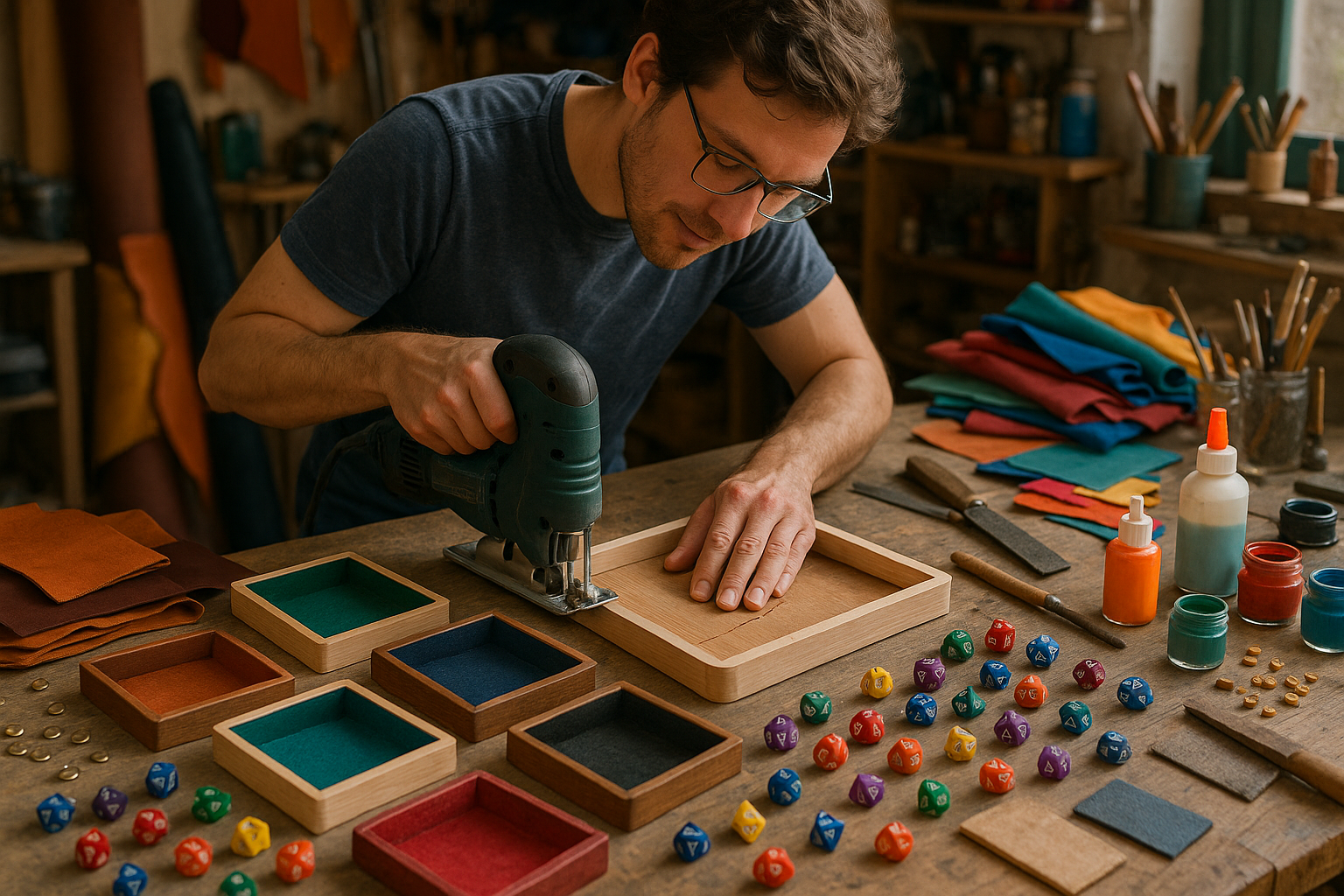🎲 But have you ever thought about how to enhance that experience and make it not just a fun gameplay element, but also a stylish one? Welcome to the world of DIY Dice Trays! This article is your comprehensive guide to crafting your luck, where we dive deep into the realm of do-it-yourself dice trays for a stylish gaming fun.
Rolling dice is an integral part of many games, but it can also be a source of frustration when they scatter all over the table, roll off the edge, or disappear under a piece of furniture. Dice trays, often overlooked, can solve this problem by providing a dedicated space for your dice to land. But why settle for a generic tray when you can create your own custom, stylish one?
Why DIY Dice Trays?
While there are numerous pre-made dice trays available on the market, crafting your own comes with its unique advantages. The freedom to select your design, materials, and size is a fantastic opportunity for personal expression. A DIY dice tray can reflect your personality, style, and even your favourite game theme, making each roll of the dice even more exciting. 🙌
Moreover, it can be a budget-friendly option, depending on the materials you choose. Not to mention the satisfaction and pride that come from using something you’ve created with your own hands. If you’re passionate about games and love DIY projects, this is a perfect blend of the two!
The Road Ahead
This article will guide you through the entire process of making your DIY dice tray, from planning your design to the final touches. The article is structured to offer detailed, step-by-step instructions, practical tips, and expert advice to help you create a dice tray that not only looks great but is functional and durable.
Whether you’re a seasoned DIYer or a newbie, don’t worry! This guide is designed to be accessible and clear for all levels. With the right tools, materials, and a bit of patience, you can create a fantastic dice tray that’s uniquely yours. 😎
The Journey Begins Here
So, are you ready to craft your luck? Your gaming sessions are about to get a stylish upgrade! If you have ever thought about adding a personalized touch to your tabletop gaming, this is your chance. Let’s dive into the exciting world of DIY dice trays and discover the fun and satisfaction of creating something truly unique. The dice are in your court…or soon will be, in your own stylish, custom dice tray! 🎲
Remember, the journey of crafting your DIY dice tray is just as important as the final product. It’s a journey of creativity, patience, and fun. So, roll up your sleeves and let’s get crafting!
Unleashing Your Creative Side: The Basics of DIY Dice Trays
Whether you’re a die-hard tabletop gamer or simply someone who appreciates an element of style and practicality, a dice tray can be a great addition to your gaming repertoire. The beauty of creating a DIY dice tray is that it provides an opportunity to add a personal touch to your gaming experience. To assist you in this endeavor, we’ve put together a comprehensive guide on crafting your own stylish and functional dice tray.
Before diving into the specifics of building your own dice tray, it’s essential to understand what exactly a dice tray is and why you might want one. Simply put, a dice tray is a shallow box or container used to roll dice in tabletop games. This handy tool ensures that dice don’t go flying off the table and keeps them in a contained, easily visible space.
While it’s certainly possible to purchase a pre-made dice tray, creating your own allows for customization to suit your specific needs and style. Whether you prefer a minimalist design or something more intricate, the possibilities are virtually endless. But before we start crafting, let’s take a quick look at some popular dice tray designs for inspiration.
Comparing Different Dice Tray Designs
| Design Type | Description | Pros | Cons |
|---|---|---|---|
| Simple Wood Tray | A flat wooden tray with raised edges. | Easy to make, durable, minimalist design. | Lacks additional features like dice storage or rolling surfaces. |
| Felt-Lined Tray | A wooden tray with a felt-lined rolling surface. | Provides a soft surface for rolling, enhances dice visibility. | Requires additional materials and steps to construct. |
| Multi-Compartment Tray | A tray with separate compartments for dice storage and rolling. | Offers storage solution, keeps dice organized. | Complex design, may be challenging to build. |
Now that you’ve got a sense of the various design options, it’s time to consider the materials you’ll need for your DIY dice tray project. Remember, the type of material you choose will largely depend on your personal preference and the design you’ve chosen.
Choosing Your Materials: From Basic to Advanced
When it comes to materials for your DIY dice tray, the world is your oyster. From different types of wood to fabrics and finishes, your material choice will ultimately dictate the look and feel of your finished product.
For a simple wooden tray, materials like pine or oak are good choices due to their strength and durability. For a more advanced tray with a felt-lined rolling surface, you’ll also need to purchase fabric, adhesive, and potentially additional tools for cutting and attaching the fabric to your tray.
If you’re planning on making a multi-compartment tray, you’ll need to consider additional materials for dividers, such as wood or even plastic. It’s important to note that this design will likely require more advanced tools and skills.
Getting Crafty: Building Your DIY Dice Tray
Once you’ve decided on your design and gathered your materials, it’s time to start building. Though the specific steps will vary depending on your chosen design, here is a basic step-by-step guide to creating a simple wooden dice tray.
Firstly, measure and mark the dimensions of your tray on your chosen wood, including the base and sides. Cut out these pieces with a saw, then sand the edges to smooth any rough areas. Next, use wood glue to attach the sides to the base, making sure to secure them firmly. Allow the glue to dry completely before proceeding.
For those creating a felt-lined tray, you’ll need to cut a piece of felt to fit the inside base of your tray. Use adhesive to attach the felt, ensuring it lays flat and smooth. If you’re creating a multi-compartment tray, you’ll need to measure, cut, and attach dividers within your tray at this point.
Once your tray is assembled and any felt or dividers are securely attached, you can add a finish to your tray if desired. This could include painting the tray, applying a wood stain, or even adding decorative elements like decals or engravings. Allow any finishes to dry completely before using your tray.
For a more detailed visual guide to creating a DIY dice tray, check out the video “DIY Dice Tray Tutorial” by channel Crafting Muse on YouTube.
Rolling with Style: Personalizing Your Dice Tray
One of the best parts about creating a DIY dice tray is the ability to personalize it. Whether you choose to incorporate your favorite colors, add an engraved design, or even include compartments specifically designed to fit your favorite dice sets, the possibilities are endless.
Consider adding a splash of color with paint or stain, or make your tray truly unique with custom decals or engravings. You could even add a leather or fabric lining to the rolling surface for an extra touch of luxury. Remember, this is your tray and it should reflect your personal style and gaming preferences.
Personalizing your tray isn’t just about aesthetics, though. Adding features like dice storage compartments, dice towers, or even built-in rolling surfaces can take your gaming experience to the next level. These additions are not only practical but can also add a fun and unique element to your gaming sessions.
Sharing the Fun: DIY Dice Trays as Gifts
DIY dice trays aren’t just a great project for yourself—they also make thoughtful, personalized gifts for the gamers in your life. Whether for a birthday, holiday, or just because, a handmade dice tray is a gift that any tabletop gamer will appreciate and use for years to come.
When making a dice tray as a gift, consider the recipient’s gaming preferences and personal style. Choose materials and designs that reflect their favorite games or themes, and don’t be afraid to get creative with personal touches. Whether it’s their favorite color, an engraved design, or a compartment for their prized dice set, these small details can make a big impact.
So why wait? It’s time to get crafting! Whether for yourself or as a gift, a DIY dice tray is a fun and functional project that’s sure to add a touch of style to any gaming session. So roll the dice and start crafting your luck today!

Conclusion
In conclusion, this article has strived to demystify the complex landscape of Information Technology and Engineering. It has outlined key concepts, explained technical intricacies, and provided insights into areas often misunderstood or overlooked.
From the discussion on software architecture, the importance of quality assurance, to the role of data structures in modern applications, this article has traversed the realms of software engineering and IT, with the aim of providing you with a comprehensive and accessible understanding.💡
Understanding these topics is no longer exclusive to IT professionals or software engineers. In this digital era, where technology is intertwined with our daily lives, a basic understanding of these technical topics can empower us all, and enable us to appreciate the world around us.
In software architecture, for instance, we learned about the significance of structure and design in software development. It goes beyond just writing code, but instead requires strategic planning and thoughtful organization, much like constructing a building. 🏢
In discussing quality assurance, we revealed its pivotal role in ensuring the smooth operation of software. It is the safety net that catches errors and bugs before they reach the user, highlighting the importance of thorough testing and quality checks.🔍
Finally, in our exploration of data structures, we discovered how they form the backbone of any software application. Whether it’s an array, a linked list, or a binary tree, each data structure has its own unique role and significance in shaping the functionality and performance of a program. 📊
Remember, the goal of this article was not just to inform, but also to inspire. The world of IT and software engineering is vast and full of opportunities. It is my hope that this piece has sparked your curiosity, and perhaps even encouraged you to delve deeper into these topics.
If you’ve found this information useful, please feel free to share it with others who might benefit. 🔄 And if you have any questions, thoughts, or insights, I encourage you to comment below. I value your feedback and would love to hear your perspective.
To further enrich your understanding, I would recommend exploring resources such as the [Computer Science Education Resource Center](http://www.csedweek.org/), [IEEE Xplore](https://ieeexplore.ieee.org/Xplore/home.jsp), and the [ACM Digital Library](https://dl.acm.org/). These are reputable and active sources of up-to-date information and research in the field.
Remember, knowledge is power, and continuous learning is the key to unlocking that power. 🔑
Thank you for accompanying me on this journey of discovery. Until next time, keep exploring, keep learning, and keep pushing the boundaries of your understanding.💫
References:
1. Computer Science Education Resource Center. (n.d.). [http://www.csedweek.org/](http://www.csedweek.org/)
2. IEEE Xplore. (n.d.). [https://ieeexplore.ieee.org/Xplore/home.jsp](https://ieeexplore.ieee.org/Xplore/home.jsp)
3. ACM Digital Library. (n.d.). [https://dl.acm.org/](https://dl.acm.org/)



